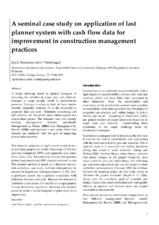| dc.description.abstract | A major challenge faced by project managers is balancing the variables of scope, cost, and schedule. Changes in scope usually result in cost/schedule overruns. Variance in either or both of them creates disorder (typically increases it) in the estimated or projected time and cost. Therefore, controlling cost and schedule are two of the most critical aspects of a construction project. This research uses two already existing management theories, specifically Management by Means (MBM) and Management by Results (MBR), and analyzes a case where these two theories are combined with the goal of improving construction practices.
This research compares an eight month schedule in a construction project and relates Percentage of Planned activities Completed (PPC) with projected and actual draw (cash) calls. The research analyzes the question of how lean construction PPC captures variance in cost. The research method is based on a literature review, data collection, case study and data interpretation to answer the hypothesis that improvement in PPC over a particular month has a positive correlation with difference between cash calls. Because this research is limited to a time frame of 8 months in a single project, it is not statistically significant. However, this research serves to create a model template or pilot study for a larger study. | en |


